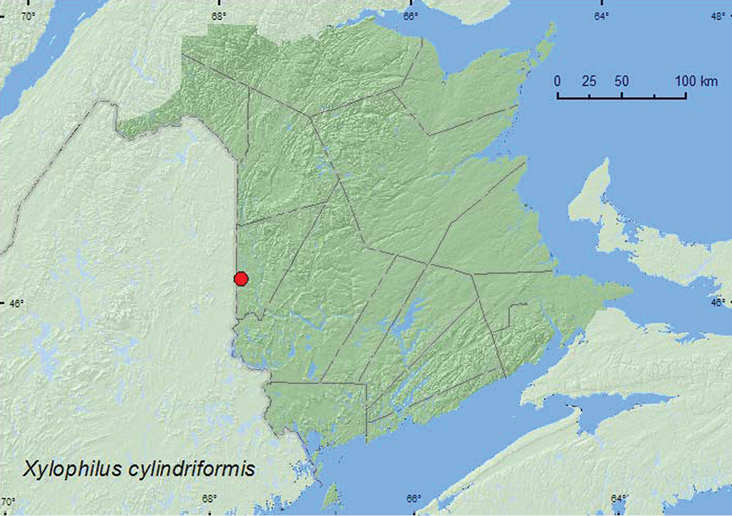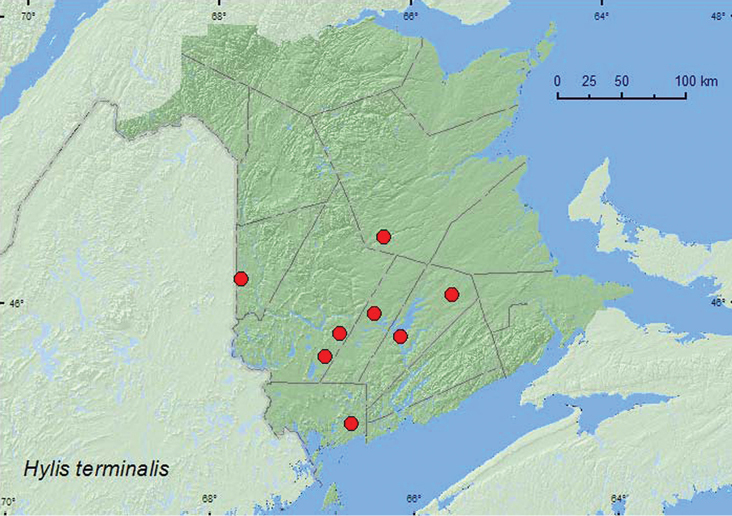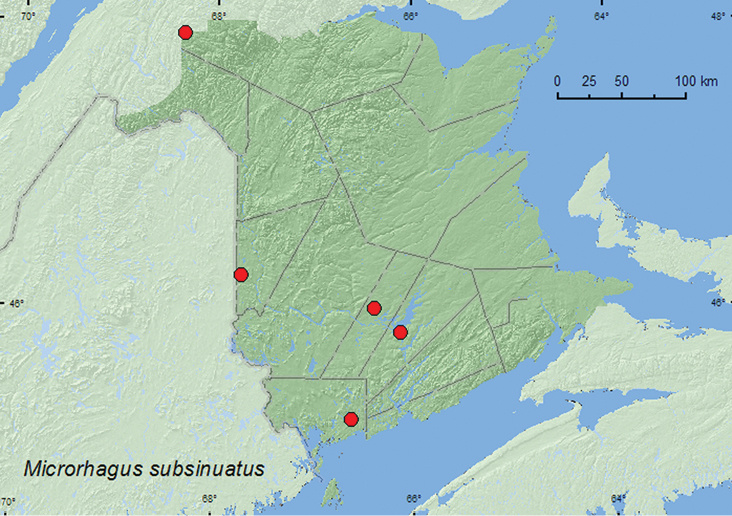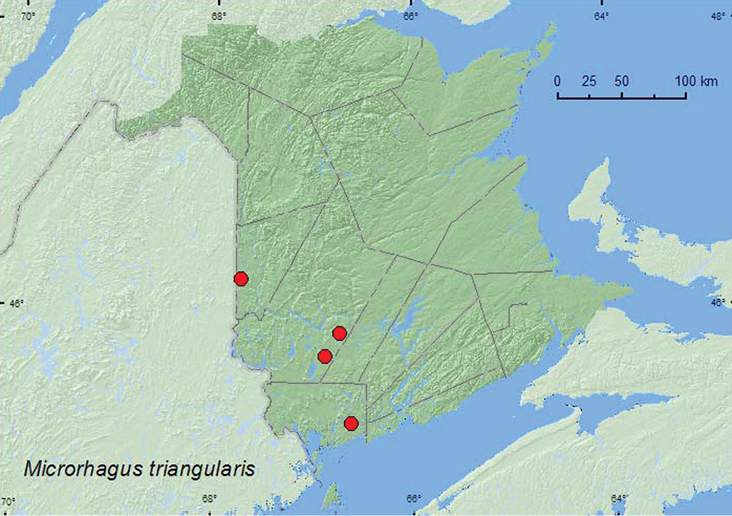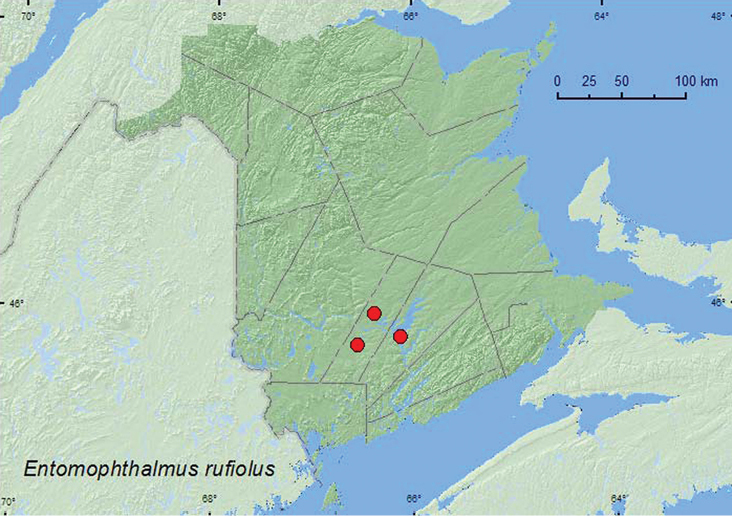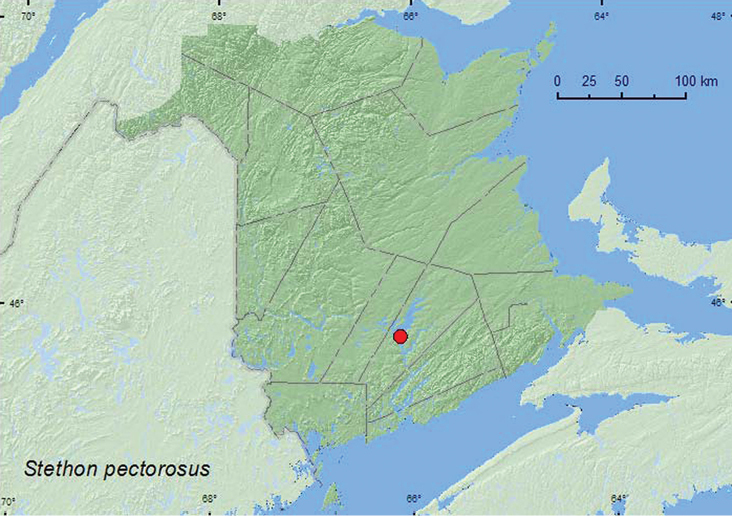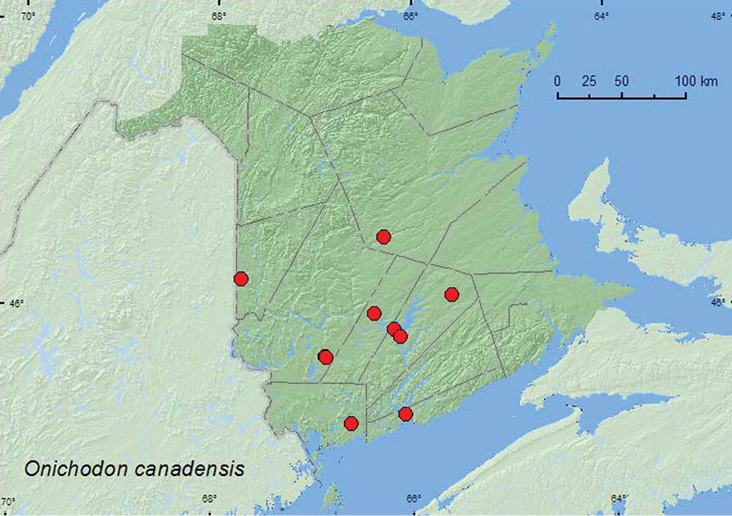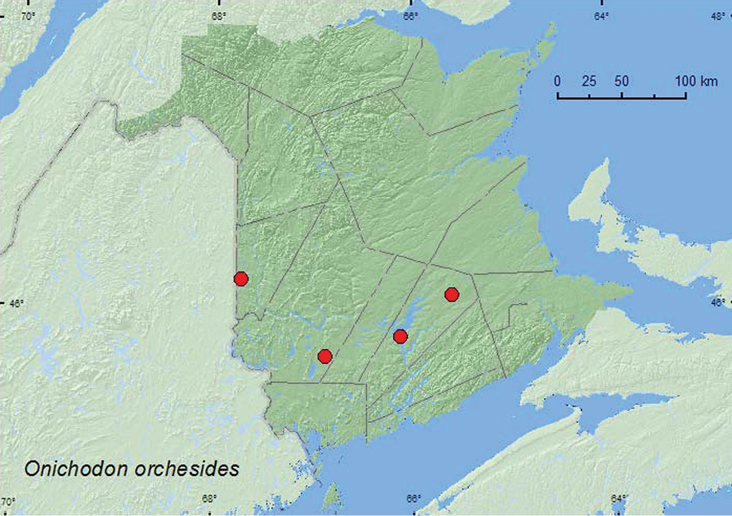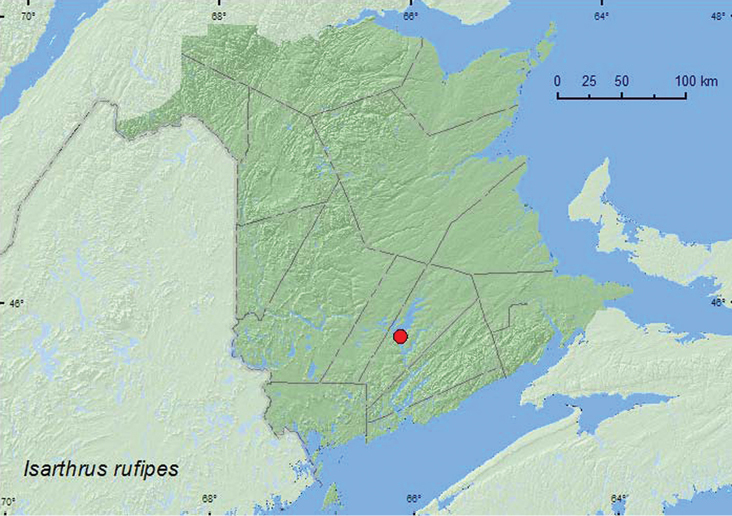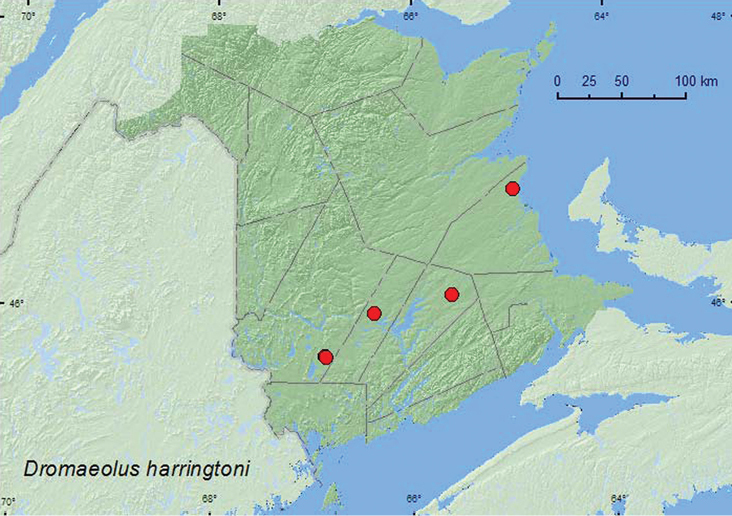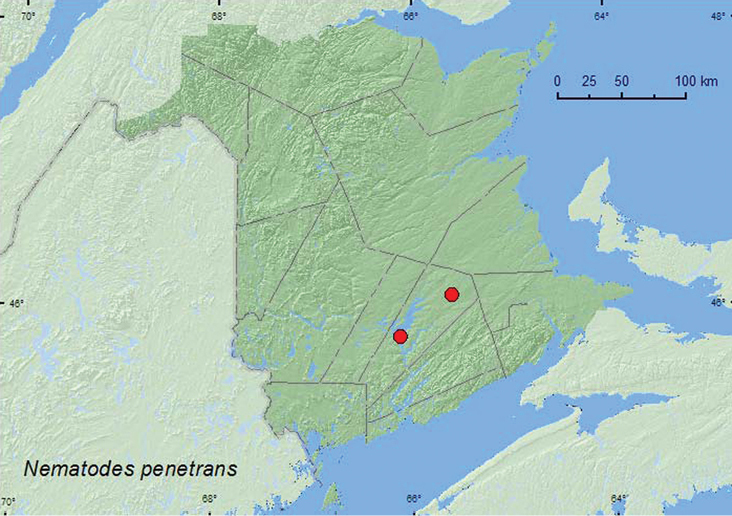






(C) 2012 Reginald P. Webster. This is an open access article distributed under the terms of the Creative Commons Attribution License 3.0 (CC-BY), which permits unrestricted use, distribution, and reproduction in any medium, provided the original author and source are credited.
For reference, use of the paginated PDF or printed version of this article is recommended.
We report nine species of Eucnemidae new to the province and additional records for Onichodon canadensis (Brown) and Dromaeolus harringtoni Horn. Five species, Xylophilus cylindriformis (Horn), Entomophthalmus rufiolus (LeConte), Stethon pectorosus LeConte, Onichodon orchesides Newman, and Isarthrus rufipes (Melsheimer), are newly recorded for the Maritime provinces. This brings the total number of Eucnemidae recorded from New Brunswick to 15 species. Lindgren funnel traps are an effective tool for sampling the Eucnemidae.
Eucnemidae, taxonomy, Canada, New Brunswick, new records, Lindgren funnel traps
The Nearctic Eucnemidae (false click beetles) was revised by
The following records are based on specimens collected as part of a general survey by the first author to document the Coleoptera fauna of New Brunswick. Additional provincial records were obtained from specimens contained in the collection at the Atlantic Forestry Centre, Natural Resources Canada, Canadian Forest Service, Fredericton, New Brunswick.
Collection methodsVarious collection methods were employed to collect the Eucnemidae reported in this study. Details are outlined in
Distribution maps, created using ArcMap and ArcGIS, are presented for each species in New Brunswick. Every species is cited with current distribution in Canada and Alaska, using abbreviations for the state, provinces, and territories. New records for New Brunswick are indicated in bold under Distribution in Canada and Alaska. The following abbreviations are used in the text:
| AK | Alaska | MB | Manitoba |
| YT | Yukon Territory | ON | Ontario |
| NT | Northwest Territories | QC | Quebec |
| NU | Nunavut | NB | New Brunswick |
| BC | British Columbia | PE | Prince Edward Island |
| AB | Alberta | NS | Nova Scotia |
| SK | Saskatchewan | NF & LB | Newfoundland and Labrador |
Acronyms of collections examined or where specimens reside referred to in this study are as follows:
AFC Atlantic Forestry Centre, Natural Resources Canada, Canadian Forest Service, Fredericton, New Brunswick, Canada
CNC Canadian National Collection of Insects, Arachnids and Nematodes, Agriculture and Agri-Food Canada, Ottawa, Ontario, Canada
NBM New Brunswick Museum, Saint John, New Brunswick, Canada
RWC Reginald P. Webster Collection, Charters Settlement, New Brunswick, Canada
ResultsWe report nine species new to the province of New Brunswick and additional records for Onichodon canadensis (Brown) and Dromaeolus harringtoni Horn. Five species, Xylophilus cylindriformis (Horn), Entomophthalmus rufiolus (LeConte), Stethon pectorosus LeConte, Onichodon orchesides Newman, and Isarthrus rufipes (Melsheimer), are newly recorded for the Maritime provinces. This brings the total number of Eucnemidae recorded from New Brunswick to 15 species (Table 1).
Eucnemidae recorded from New Brunswick, Canada and number collected using various collection methods
| Species | Lindgren funnel traps | Window traps | Other collecting methods1 |
|---|---|---|---|
| Subfamily Melasinae Fleming | |||
| Tribe Melasini Fleming | |||
| Isorhipis obliqua (Say) | 26 | 4 | 7 |
| Tribe Xylobiini Reitter | |||
| Xylophilus cylindriformis (Horn)** | 13 | ||
| Tribe Epiphanini Muona | |||
| Epiphanis cornutus (Eschscholtz) | 30 | 1 | |
| Hylis terminalis (LeConte)* | 21 | 1 | 1 |
| Tribe Dirhagini Reitter | |||
| Microrhagus pectinatus LeConte | 4 | 1 | 1 |
| Microrhagus subsinuatus LeConte* | 22 | 1 | |
| Microrhagus triangularis (Say)* | 6 | 1 | |
| Entomophthalmus rufiolus (LeConte)** | 4 | ||
| Subfamily Eucneminae Eschscholtz | |||
| Tribe Mesogenini Muona | |||
| Stethon pectorosus LeConte** | 1 | ||
| Subfamily Macraulacinae Fleutiaux | |||
| Tribe Macraulacini Fleutiaux | |||
| Onichodon canadensis (Brown) | 37 | 1 | 2 |
| Onichodon orchesides Newman** | 6 | ||
| Isarthrus rufipes (Melsheimer)** | 2 | ||
| Dromaeolus harringtoni Horn | 28 | 1 | |
| Deltometopus amoenicornis (Say) | 10 | 5 | |
| Tribe Nematodini Leiler | |||
| Nematodes penetrans (LeConte)* | 28 | ||
| Total | 238 | 7 | 20 |
Notes: *New to province; **New to Maritime provinces.
1 Other collecting methods include hand collecting, sweeping, and beating foliage.
All records below are species newly recorded for New Brunswick, Canada, unless noted otherwise (additional records). Species followed by ** are newly recorded from the Maritime provinces of Canada.
The classification of the Eucnemidae follows
Subfamily Melasinae Fleming, 1821
Tribe Xylobiini Reitter, 1911
New Brunswick, Carleton Co., Jackson Falls, “Bell Forest”, 46.2200°N, 67.7231°W, 12–19.VI.2008, 5–12.VII.2008, 12–19.VII.2008, R. P. Webster, mature hardwood forest, Lindgren funnel traps (7, AFC, RWC); same locality and habitat but 28.VI–7.VII.2009, 7–14.VII.2009, 19–31.VII.2009, R. Webster & M.-A. Giguère, Lindgren funnel traps (6, AFC, RWC).
Collection localities in New Brunswick, Canada of Xylophilus cylindriformis.
BC, ON, QC, NB (
New Brunswick, Carleton Co., Jackson Falls, Bell Forest, 46.2200°N, 67.7231°W, 12–19.VII.2008, R. P. Webster, mature hardwood forest, Lindgren funnel trap (1, AFC); same locality and habitat but 7–12.VIII.2009, R. Webster & M.-A. Giguère, Lindgren funnel trap (1, RWC). Charlotte Co., 10 km NW of New River Beach, 45.2110°N, 66.6170°W, 10–23.VIII.2010, C. Hughes & K. Burgess, old growth eastern white cedar forest, Lindgren funnel trap (1, NBM). Northumberland Co., Priceville, 27.VII.1972, N. Carter, window trap (1, AFC). Queens Co., Cranberry Lake P.N.A. (Protected Natural Area), 46.1125°N, 65.6075°W, 14–19.VIII.2009, R. Webster & M.-A. Giguère, old red oak forest, Lindgren funnel trap (1, AFC); same locality data and forest type, 7–13.VII.2011, 13–20.VII.2011, 20.VII–4.VIII.2011, 4–18.VIII.2011, 18–31.VIII.2011, M. Roy & V. Webster, Lindgren funnel traps in forest canopy (12, AFC, NBM, RWC); Grand Lake Meadows P.N.A., 45.8227°N, 66.1209°W, 29.VI-12.VII.2010, R. Webster, C. MacKay, M. Laity, & R. Johns, old silver maple forest with green ash and seasonally flooded marsh, Lindgren funnel trap (1, RWC). Sunbury Co., Acadia Research Forest, 45.9866°N, 66.3841°W, 13–21.VII.2009, 21–29.VII.2009, R. Webster & M.-A. Giguère, red spruce forest with red maple and balsam fir, Lindgren funnel traps (2, RWC). York Co., Charters Settlement, 45.8430°N, 66.7275°W, 11.VII.2005, R. P. Webster, regenerating mixed forest, beating foliage (1, RWC); 15 km W of Tracy off Rt. 645, 45.6848°N, 66.8821°W, 14–20.VII.2009, 20–29.VII.2009, R. Webster & M.-A. Giguère, old red pine forest, Lindgren funnel traps (2, AFC, RWC); same locality and habitat data but 30.VI–13.VII.2009, R. Webster, K. Burgess, & C. Hughes, Lindgren funnel traps (3, AFC, RWC).
Collection localities in New Brunswick, Canada of Hylis terminalis.
Hylis terminalis has been reared from Carya (
MB, ON, QC, NB, PE, NS (
New Brunswick, Carleton Co., Jackson Falls, Bell Forest, 46.2200°N, 67.7231°W, 5–12.VII.2008, 12–19.VII.2008, 19–28.VII.2008, R. P. Webster, mature hardwood forest, Lindgren funnel traps (5, AFC, RWC); same locality and habitat but 7–12.VIII.2009, R. Webster & M.-A. Giguère, Lindgren funnel trap (1, RWC); same locality and habitat but, 13.VIII.2007, R. P. Webster, sweeping foliage (1, RWC). Charlotte Co., 10 km NW of New River Beach, 45.2110°N, 66.6170°W, 29.VI-16.VII.2010, R. Webster & C. MacKay, old growth eastern white cedar forest, Lindgren funnel trap (1, RWC). Queens Co., Grand Lake Meadows P.N.A., 45.8227°N, 66.1209°W, 29.VI–12.VII.2010, 12–26.VII.2010, R. Webster, C. MacKay, M. Laity, & R. Johns, old silver maple forest with green ash and seasonally flooded marsh, Lindgren funnel traps (5, AFC, RWC); same locality data and forest type, 19.VII–5.VIII.2011, M. Roy & V. Webster, Lindgren funnel trap (1, NBM). Restigouche Co., Dionne Brook P.N.A., 47.9030°N, 68.3503°W, 28.VII–9.VIII.2011, M. Roy & V. Webster, old-growth northern hardwood forest, Lindgren funnel trap (1, RWC); same locality and collectors but 47.9064°N, 68.3441°W, 14–28.VII.2011, 28.VII–9.VIII.2011, old-growth white spruce and balsam fir forest, Lindgren funnel traps (6, AFC, NBM, RWC). Sunbury Co., Acadia Research Forest, 45.9866°N, 66.3841°W, 21–29.VII.2009, R. Webster & M.-A. Giguère, red spruce forest with red maple and balsam fir, Lindgren funnel trap (1, RWC).
Collection localities in New Brunswick, Canada of Microrhagus subsinuatus.
Microhagus subsinuatus was reared from a moist, decayed Fagus grandifolia log (
MB, ON, QC, NB, PE, NS (
New Brunswick, Carleton Co., Jackson Falls, Bell Forest, 46.2200°N, 67.7231°W, 28.VII–6.VIII.2008, R. P. Webster, mature hardwood forest, Lindgren funnel traps (2, RWC). Charlotte Co., 10 km NW of New River Beach, 45.2110°N, 66.6170°W, 29.VI–16.VII.2010, R. Webster & C. MacKay, old growth eastern white cedar forest, Lindgren funnel trap (1, AFC). York Co., Charters Settlement, 45.8430°N, 66.7275°W, 20.VII.2008, R. P. Webster, regenerating mixed forest, beating foliage (1, RWC); 15 km W of Tracy off Rt. 645, 45.6848°N, 66.8821°W, 30.VI–13.VII.2010, 12–27.VII.2010, R. Webster & C. MacKay, old red pine forest, Lindgren funnel traps (3, AFC).
Collection localities in New Brunswick, Canada of Microrhagus triangularis.
Adults of Microrhagus triangularis were reported from Cornus logs, otherwise little is known about the biology and habitat requirements of this species (
ON, QC, NB, NS (
http://species-id.net/wiki/Entomophthalmus_rufiolus
Map 5New Brunswick, Queens Co., Grand Lake Meadows P.N.A., 45.8227°N, 66.1209°W, 5–19.VII.2011, 19.VII–5.VIII.2011, M. Roy & V. Webster, old silver maple forest and seasonally flooded marsh, Lindgren funnel traps (2, RWC). Sunbury Co., Burton, near Sunpoke Lake, 45.7658°N, 66.5546°W , 24.VII–1.VIII.2008, R. P. Webster, oak forest with scattered white pine, Lindgren funnel trap (1, RWC); Acadia Research Forest, 45.9866°N, 66.3841°W, 8–13.VII.2009, R. Webster & M.-A. Giguère, red spruce forest with red maple and balsam fir, Lindgren funnel trap (1, RWC).
Collection localities in New Brunswick, Canada of Entomophthalmus rufiolus.
Entomophthalmus rufiolus has been collected from hickory (Carya sp.), at black-light traps, window traps, and a Coleman lantern light trap (
ON, QC, NB (
Tribe Mesogenini Muona, 1993
New Brunswick, Queens Co., Grand Lake Meadows P.N.A., 45.8227°N, 66.1209°W, 19.VII-5.VIII.2011, M. Roy & V. Webster, old silver maple forest and seasonally flooded marsh, Lindgren funnel trap (1, RWC).
Collection localities in New Brunswick, Canada of Stethon pectorosus.
Most records of this species are from under bark of various species of deciduous trees, otherwise little is known about its biology (
ON, QC, NB (
Tribe Macraulacini Fleutiaux, 1923
Additional New Brunswick records. Carleton Co., Jackson Falls, Bell Forest, 46.2200°N, 67.7231°W, 19–28.VII.2008, R. P. Webster, mature hardwood forest, Lindgren funnel trap (1, RWC). Charlotte Co., 10 km NW of New River Beach, 45.2110°N, 66.6170°W, 29.VI–16.VII.2010, 16–26.VII.2010, R. Webster & C. MacKay, old growth eastern white cedar forest, Lindgren funnel traps (2, AFC). Northumberland Co., Priceville, 19.VII.1972, N. Carter, window trap (1 AFC). Queens Co., Grand Lake near Scotchtown, 45.8762°N, 66.1816°W, 9.VII.2006, R. P. Webster, (red) oak and maple forest, m.v. light (1, RWC); Grand Lake Meadows P.N.A., 45.8227°N, 66.1209°W, 5–19.VII.2011, 19.VII–5.VIII.2011, 5–17.VIII.2011, M. Roy & V. Webster, old silver maple forest and seasonally flooded marsh, Lindgren funnel traps (6, NBM, RWC); Cranberry Lake P.N.A., 46.1125°N, 65.6075°W, 20.VII–4.VIII.2011, 4–18.VIII.2011, M. Roy & V. Webster, Lindgren funnel traps in forest canopy (2, NBM, RWC). Sunbury Co., Acadia Research Forest, 45.9866°N, 66.3841°W, 21–29.VII.2009, R. Webster & M.-A. Giguère, red spruce forest with red maple and balsam fir, Lindgren funnel traps (2, AFC, RWC). York Co., 15 km W of Tracy off Rt. 645, 45.6848°N, 66.8821°W, 20–29.VII.2009, 4–11.VIII.2010, R. Webster & M.-A. Giguère, old red pine forest, Lindgren funnel traps (3, AFC, RWC); same locality and habitat data but 30.VI-13.VII.2010, 13–27.VII.2010, 27.VII-10.VIII.2010, R. Webster, C. MacKay, & K. Burgess, Lindgren funnel traps (most in forest canopy) (19, AFC, NBM, RWC); 14 km WSW of Tracy, S of Rt. 645, 45.6741°N, 66.8661°W, 30.VI-13.VII.2010, R. Webster & C. MacKay, old mixed forest with red and white spruce, red and white pine, balsam fir, eastern white cedar, red maple, and Populus sp., Lindgren funnel traps (3, AFC).
Collection localities in New Brunswick, Canada of Onichodon canadensis.
Onichodon canadensis has been reared from decayed yellow birch (Betula alleghaniensis Britt.), collected at black lights, and found on red spruce and Fagus sp. (
ON, QC, NB, PE, NS (
New Brunswick, Carleton Co., Jackson Falls, Bell Forest, 46.2200°N, 67.7231°W, 12–19.VII.2008, 19–31.VII.2008, R. P. Webster, mature hardwood forest, Lindgren funnel traps (2, AFC, RWC); same locality and habitat but 19–31.VII.2009, R. Webster & M.-A. Giguère, Lindgren funnel trap (1, RWC). Queens Co., Cranberry Lake P.N.A, 46.1125°N, 65.6075°W, 21–28.VII.2009, R. Webster & M.-A. Giguère, old red oak forest, Lindgren funnel trap (1, RWC); Grand Lake Meadows P.N.A., 45.8227°N, 66.1209°W, 19.VII–5.VIII.2011, M. Roy & V. Webster, old silver maple forest and seasonally flooded marsh, Lindgren funnel trap (1, RWC). York Co., 15 km W of Tracy off Rt. 645, 45.6848°N, 66.8821°W, 13–27.VII.2010, R. Webster & C. MacKay old red pine forest, Lindgren funnel trap (1, RWC).
Collection localities in New Brunswick, Canada of Onichodon orchesides.
Onichodon orchesides has been collected in a light trap and from sugar maple, and remains of adults have been found in a rotten poplar log, otherwise little is known about its biology (
ON, QC, NB (
New Brunswick, Queens Co., Grand Lake Meadows P.N.A., 45.8227°N, 66.1209°W, 12–26.VII.2010, R. Webster & C. MacKay, old silver maple forest with green ash and seasonally flooded marsh, Lindgren funnel traps (2, RWC).
Collection localities in New Brunswick, Canada of Isarthrus rufipes.
This uncommon species has been reared from decayed American beech logs (
ON, NB (
Additional New Brunswick Records. Queens Co., Cranberry Lake P.N.A, 46.1125°N, 65.6075°W, 15–21.VII.2009, 21–28.VII.2009, 28.VII–6.VIII.2009, 6–14.VIII.2009, R. Webster & M.-A. Giguère, old red oak forest, Lindgren funnel traps (11, AFC, RWC); same locality data and forest type, 20.VII–4.VIII.2011, 4–18.VIII.2011, M. Roy & V. Webster, Lindgren funnel traps (10, AFC, NBM, RWC). Sunbury Co., Acadia Research Forest, 45.9866°N, 66.3841°W, 21–29.VII.2009, 4–11.VIII.2009, 11–18.VIII.2009, R. Webster & M.-A. Giguère, red spruce forest with red maple and balsam fir, Lindgren funnel traps (3, AFC, RWC). York Co., 15 km W of Tracy off Rt. 645, 45.6848°N, 66.8821°W, 13–27.VII.2010, 27.VII–10.VIII.2010, R. Webster, C. MacKay, & C. Hughes, old red pine forest, Lindgren funnel traps (2, AFC, RWC); 14 km WSW of Tracy, S of Rt. 645, 45.6741°N, 66.8661°W, 13–27.VII.2010, R. Webster & C. MacKay, old mixed forest with red and white spruce, red and white pine, balsam fir, eastern white cedar, red maple, and Populus sp., Lindgren funnel traps (2, AFC).
Collection localities in New Brunswick, Canada of Dromaeolus harringtoni.
Dromaeolus harringtoni was collected on beech (
MB, ON, QC, NB (
New Brunswick, Queens Co., Grand Lake Meadows P.N.A., 45.8227°N, 66.1209°W, 29.VI-12.VII.2010, R. Webster, C. MacKay, M. Laity, & R. Johns, old silver maple forest with green ash and seasonally flooded marsh, Lindgren funnel trap (1, RWC); same locality data and forest type, 19.VII–5.VIII.2011, 5–17.VIII.2011, M. Roy & V. Webster, Lindgren funnel traps in forest canopy (5, AFC, NBM, RWC); Cranberry Lake P.N.A, 46.1125°N, 65.6075°W, M. Roy & V. Webster, 13–20.VII.2011, 20.VII–4.VIII.2011, 4–18.VIII.2011, old red oak forest, Lindgren funnel traps in forest canopy (22, AFC, NBM, RWC).
Collection localities in New Brunswick, Canada of Nematodes penetrans.
Nematodes penetrans was reared from American beech (
ON, QC, NB, NS (
We thank Caroline Simpson for editing this manuscript. Three anonymous reviewers are thanked for their helpful comments that improved this manuscript. Serge Laplante (Agriculture and Agri-Food Canada (CNC), Ottawa) is thanked for assistance determining specimens. We thank Nichole Brawn, Katie Burgess, Marie-Andrée Giguère, Nancy Harn, Cory Hughes, Rob Johns, Ervin Kovacs, Marsell Laity, Colin MacKay, Wayne MacKay, Jessica Price, Michelle Roy, and Vincent Webster for technical assistance and collecting specimens. We thank Natural Resources Canada, Canadian Forest Service; the Canadian Food Inspection Agency; and USDA APHIS for funding the study on early detection of invasive cerambycids, which provided many specimens in Lindgren funnel traps. The New Brunswick Environmental Trust Fund and New Brunswick Wildlife Trust Fund are thanked for funding various insect surveys over the past 6 years, and the Meduxnekeag River Association for permission to sample beetles at the Meduxnekeag Valley Nature Preserve (which includes the Bell Forest). The New Brunswick Department of Natural Resources (Fish and Wildlife Branch) is thanked for issuing permits for sampling in the Protected Natural Areas.
